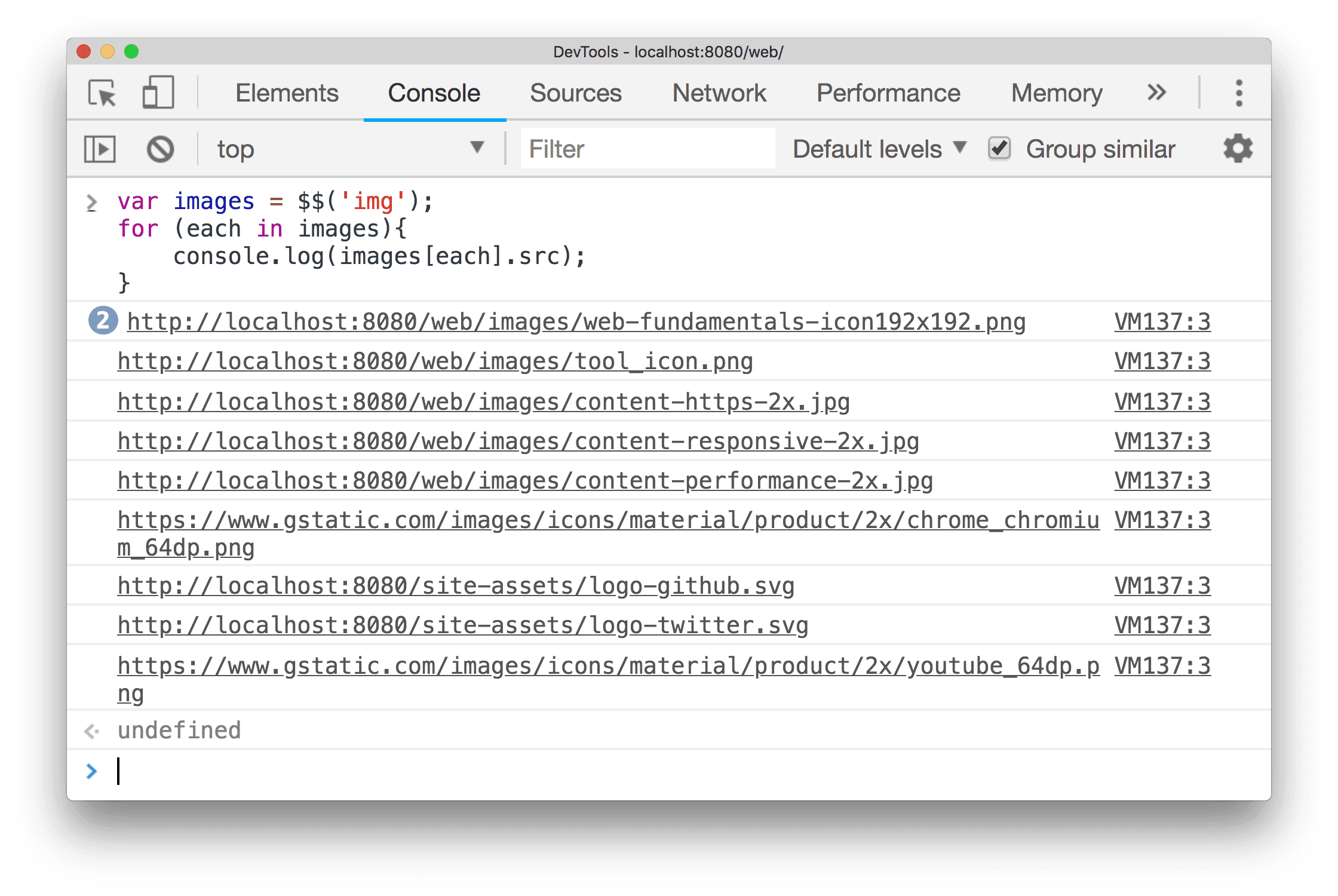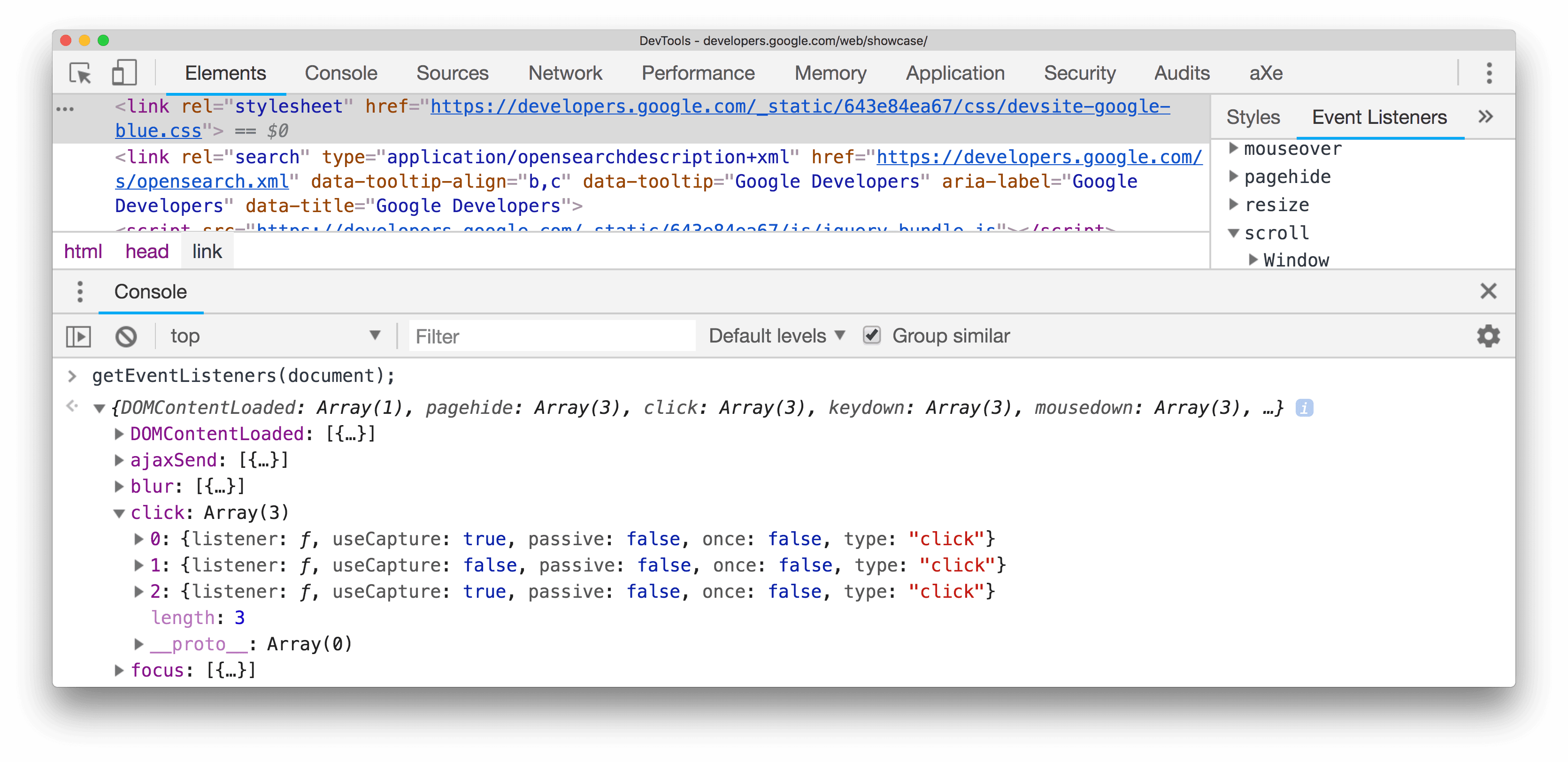The Console Utilities API contains a collection of convenience functions for performing common tasks: selecting and inspecting DOM elements, querying objects, displaying data in readable format, stopping and starting the profiler, monitoring DOM events and function calls, and more.
Looking for console.log(), console.error(), and the rest of the console.* functions? See
Console API Reference.
$_
$_ returns the value of the most recently evaluated expression.
In the following example, a simple expression (2 + 2) is evaluated. The $_ property is then
evaluated, which contains the same value:

In the next example, the evaluated expression initially contains an array of names. Evaluating
$_.length to find the length of the array, the value stored in $_ changes to become the latest
evaluated expression, 4:

$0 - $4
The $0, $1, $2, $3 and $4 commands work as a historical reference to the last five DOM
elements inspected within the Elements panel or the last five JavaScript heap objects selected in
the Profiles panel. $0 returns the most recently selected element or JavaScript object, $1
returns the second most recently selected one, and so on.
In the following example, an img element is selected in the Elements panel. In the Console drawer,
$0 has been evaluated and displays the same element:

The image below shows a different element selected in the same page. The $0 now refers to newly
selected element, while $1 returns the previously selected one:

$(selector [, startNode])
$(selector) returns the reference to the first DOM element with the specified CSS selector. When
called with one argument, this function is a shortcut for the document.querySelector() function.
The following example returns a reference to the first <img> element in the document:

Right-click on the returned result and select Reveal in Elements Panel to find it in the DOM, or Scroll in to View to show it on the page.
The following example returns a reference to the currently selected element and displays its src
property:

This function also supports a second parameter, startNode, that specifies an 'element' or Node from
which to search for elements. The default value of this parameter is document.
The following example returns a reference to the first img element that is a descendant of devsite-header-background, and
displays its src property:

$$(selector [, startNode])
$$(selector) returns an array of elements that match the given CSS selector. This command is
equivalent to calling Array.from(document.querySelectorAll()).
The following example uses $$() to create an array of all <img> elements in the current document
and displays the value of each element's src property:
let images = $$('img');
for (let each of images) {
console.log(each.src);
}

This function also supports a second parameter, startNode, that specifies an element or Node from
which to search for elements. The default value of this parameter is document.
This modified version of the previous example uses $$() to create an array of all <img> elements
that appear in the current document after the selected Node:
let images = $$('img', document.querySelector('.devsite-header-background'));
for (let each of images) {
console.log(each.src);
}

$x(path [, startNode])
$x(path) returns an array of DOM elements that match the given XPath expression.
For example, the following returns all the <p> elements on the page:
$x("//p")

The following example returns all the <p> elements that contain <a> elements:
$x("//p[a]")

Similar to the other selector functions, $x(path) has an optional second parameter, startNode,
that specifies an element or Node from which to search for elements.

clear()
clear() clears the console of its history.
clear();
copy(object)
copy(object) copies a string representation of the specified object to the clipboard.
copy($0);
debug(function)
When the specified function is called, the debugger is invoked and breaks inside the function on the Sources panel allowing to step through the code and debug it.
debug(getData);

Use undebug(fn) to stop breaking on the function, or use the UI to disable all breakpoints.
For more information on breakpoints, see Pause Your Code With Breakpoints.
dir(object)
dir(object) displays an object-style listing of all the specified object's properties. This method
is a shortcut for the Console API's console.dir() method.
The following example shows the difference between evaluating document.body directly in the
command line, and using dir() to display the same element:
document.body;
dir(document.body);

For more information, see the console.dir() entry in the Console API.
dirxml(object)
dirxml(object) prints an XML representation of the specified object, as seen in the Elements panel.
This method is equivalent to the console.dirxml() method.
inspect(object/function)
inspect(object/function) opens and selects the specified element or object in the appropriate
panel: either the Elements panel for DOM elements or the Profiles panel for JavaScript heap objects.
The following example opens the document.body in the Elements panel:
inspect(document.body);

When passing a function to inspect, the function opens the document up in the Sources panel for you to inspect.
getEventListeners(object)
getEventListeners(object) returns the event listeners registered on the specified object. The
return value is an object that contains an array for each registered event type (click or
keydown, for example). The members of each array are objects that describe the listener registered
for each type. For example, the following lists all the event listeners registered on the document
object:
getEventListeners(document);

If more than one listener is registered on the specified object, then the array contains a member
for each listener. In the following example, there are two event listeners registered on the
document element for the click event:

You can further expand each of these objects to explore their properties:

For more information, see Inspect object properties.
keys(object)
keys(object) returns an array containing the names of the properties belonging to the specified
object. To get the associated values of the same properties, use values().
For example, suppose your application defined the following object:
let player = {
"name": "Parzival",
"number": 1,
"state": "ready",
"easterEggs": 3
};
Assuming player was defined in the global namespace (for simplicity), typing keys(player) and
values(player) in the Console results in the following:

monitor(function)
When the function specified is called, a message is logged to the console that indicates the function name along with the arguments that are passed to the function when it was called.
function sum(x, y) {
return x + y;
}
monitor(sum);

Use unmonitor(function) to stop monitoring.
monitorEvents(object [, events])
When one of the specified events occurs on the specified object, the Event object is logged to the console. You can specify a single event to monitor, an array of events, or one of the generic events "types" mapped to a predefined collection of events. See examples below.
The following monitors all resize events on the window object.
monitorEvents(window, "resize");

The following defines an array to monitor both "resize" and "scroll" events on the window object:
monitorEvents(window, ["resize", "scroll"])
You can also specify one of the available event "types", strings that map to predefined sets of events. The table below lists the available event types and their associated event mappings:
| Event type & Corresponding mapped events | |
|---|---|
| mouse | "mousedown", "mouseup", "click", "dblclick", "mousemove", "mouseover", "mouseout", "mousewheel" |
| key | "keydown", "keyup", "keypress", "textInput" |
| touch | "touchstart", "touchmove", "touchend", "touchcancel" |
| control | "resize", "scroll", "zoom", "focus", "blur", "select", "change", "submit", "reset" |
For example, the following uses the "key" event type all corresponding key events on an input text field currently selected in the Elements panel.
monitorEvents($0, "key");
Below is sample output after typing a characters in the text field:

Use unmonitorEvents(object[, events]) to stop monitoring.
profile([name]) and profileEnd([name])
profile() starts a JavaScript CPU profiling session with an optional name. profileEnd()
completes the profile and displays the results in the Performance > Main track.
To start profiling:
profile("Profile 1")
To stop profiling and see the results in the Performance > Main track:
profileEnd("Profile 1")
Result in the Performance > Main track:
Main track." width="800" height="606">
Profiles can also be nested. For example, this will work in any order:
profile('A');
profile('B');
profileEnd('A');
profileEnd('B');
queryObjects(Constructor)
Call queryObjects(Constructor) from the console to return an array of objects that were created
with the specified constructor. For example:
queryObjects(Promise). Returns all instances ofPromise.queryObjects(HTMLElement). Returns all HTML elements.queryObjects(foo), wherefoois a class name. Returns all objects that were instantiated vianew foo().
The scope of queryObjects() is the currently-selected execution context in the console.
table(data [, columns])
Log object data with table formatting by passing in a data object in with optional column headings.
This is a shortcut for console.table().
For example, to display a list of names using a table in the console, you would do:
let names = [
{ firstName: "John", lastName: "Smith" },
{ firstName: "Jane", lastName: "Doe" },
];
table(names);

undebug(function)
undebug(function) stops the debugging of the specified function so that when the function is
called, the debugger is no longer invoked. This is used in concert with debug(fn).
undebug(getData);
unmonitor(function)
unmonitor(function) stops the monitoring of the specified function. This is used in concert with
monitor(fn).
unmonitor(getData);
unmonitorEvents(object [, events])
unmonitorEvents(object[, events]) stops monitoring events for the specified object and events. For
example, the following stops all event monitoring on the window object:
unmonitorEvents(window);
You can also selectively stop monitoring specific events on an object. For example, the following code starts monitoring all mouse events on the currently selected element, and then stops monitoring "mousemove" events (perhaps to reduce noise in the console output):
monitorEvents($0, "mouse");
unmonitorEvents($0, "mousemove");
values(object)
values(object) returns an array containing the values of all properties belonging to the specified
object.
let player = {
"name": "Parzival",
"number": 1,
"state": "ready",
"easterEggs": 3
};
values(player);



